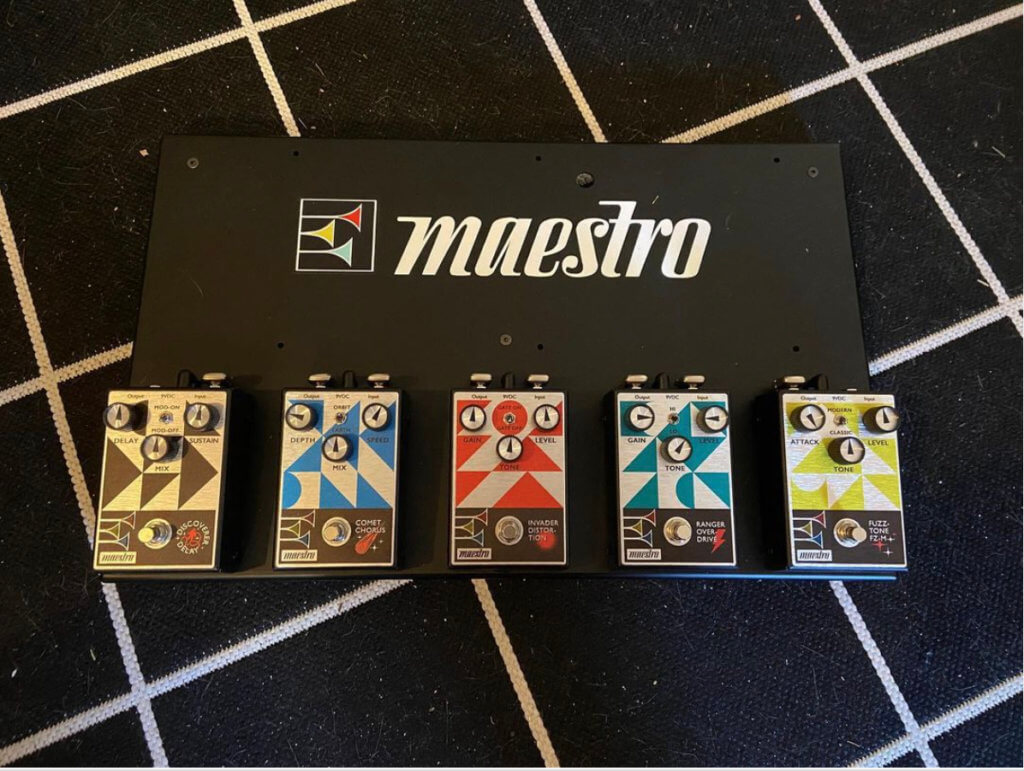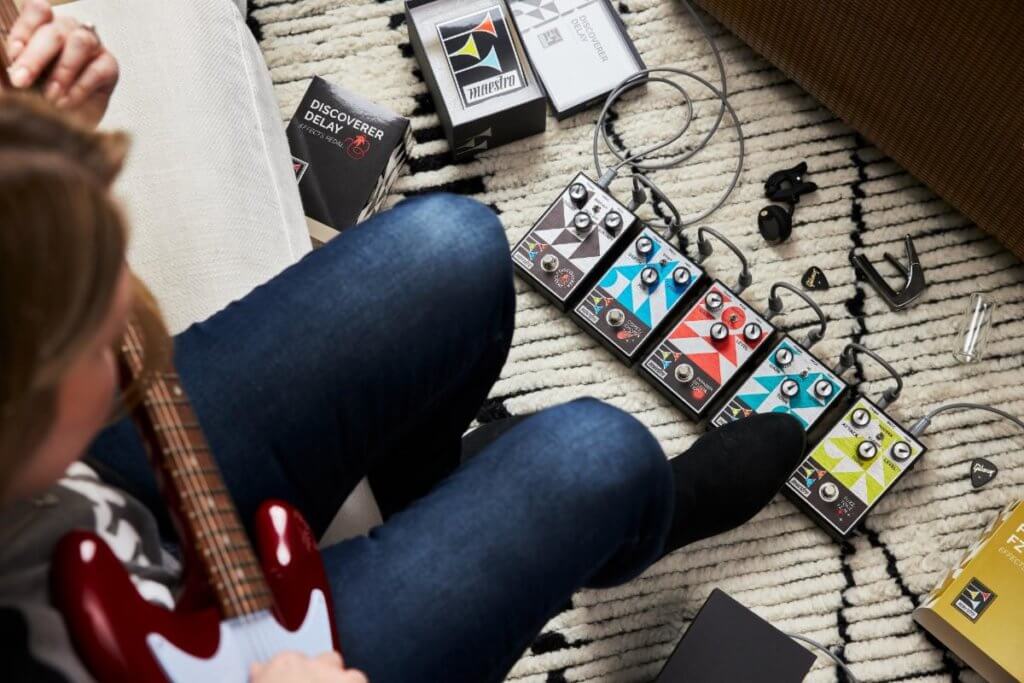Maestro is back, baby! Maestro started the whole pedal “thing” back in the 1960s; the original FZ-1 fuzz is all over “(I Can’t Get No) Satisfaction” by the Rolling Stones. Music has never been the same since. Gibson has revitalized and re-envisioned some essential guitar effects pedals by re-launching the Maestro name.
For a proper test we were provided with a complete pedalboard with the Fuzz-Tone FZ-M, Ranger Overdrive, Invader Distortion, Comet Chorus, and Discovery Delay, all wired up for sound and power.
Each pedal has a very similar control layout; 3 knobs, a toggle switch for a secondary mode, and a true bypass footswitch. The Paul Rand retro style graphics are complemented with the three colored “horns” lighting up when the effect is engaged – a super-nice touch.
The Fuzz-Tone FZ-M lives up to its reputation in the classic mode. It’s rich and can get plenty hairy at the same time. It certainly sits on the side of where a fuzz was meant to be an “effect,” and complement a guitar tone, not re-write it as a new landscape of psychedelic freak-outs. It’s still potent though and works well with both single coil and humbucking pickups and has plenty of cut and edge without getting unusably sizzly. The modern mode cleans things up a bit with more punch and presence. It’s perfect where you want the fuzz to really kick in, and not get lost in oversaturation. For players looking for a “classic plus a bit more,” this may out-do some overpriced and over-hyped fuzzes that have recently gotten some attention in forum-land.

our very own pedalboard stocked with Maestro effects!
For driving an amp, the Ranger dips into some pretty rad territory. When the mode is set to “LO,” the driven signal has a bit of the clean signal blended in, all adding up to a very rich and dynamic feel. There’s also excellent response to pick attack. It’s a “clearer” distortion that has a bit more high-end present. This is a great feature and color for cutting through for solos (and gain stacking). This could easily be one of those “always on” pedals at a lower gain setting for a more hi-fi approach to everything else in the signal chain. Either way, it could easily be the go-to mid-level drive for a lot of players.
Distortion pedals are often overlooked in modern music; a lot of players either find them too over the top, or they have some weak point in the frequency spectrum that makes them hit or miss — not here. The Invader recalls when a distortion pedal was meant to hurt the front end of an amp while still retaining some semblance of articulation. This is the ideal blend of drive and attack. The perfect test is the “all at noon” approach; if this setting works, there’s plenty of room for more gain, plenty of EQ adjustment and output level. The Invader passed this test with flying colors. There’s a lot of classic distortion pedal character, but it’s not all gooped up in gain or hiss, thanks to the selectable noise gate. Clarity and definition that still responds to picking attack usually only resides in a tube amp on the edge of hell, and it’s found in this unit as well. Lead bits sang nicely and power chords chugged through with plenty of articulation and harmonics.
Chorus pedals can easily draw ire, especially the overdone 80’s shimmery versions. However, the Comet Chorus sits more as a lo-fi version tonally. It’s certainly got a darker tone and overall warmth in the “Earth mode.” Switching into “Orbit mode” adds in a tremolo effect that feels even more like a vintage vibrato warble that is quite expansive. The pulsating modulation combo is something that usually only comes in “bouteek” pedals, and in this case it’s an option that takes things a step above the average chorus pedal. With a healthy dose of reverb and delay this could easily be an analog soundscapist’s new dream device.
The Discover Delay uses a bucket brigade style circuit to capture those classic early analog delays. Simplicity rules here, and for a slapback, tape echo style, it sits nicely in a mix. Like the Chorus, there is a darker presence that in this case adds a bit of texture to the effect. It tops out at 600 milliseconds, so for any classic delay tones, this has everything covered, and there’s a lot to be had in those areas, from clicky-clacky upper-range pedal tones to “let it hang” solos that remain in the air after the notes naturally decay. The modulation option gets very warbly with the delayed signal getting processed, and kind of feels more like a vibrato, but still has a nice and haunting effect.

There are some internal trim pots on the Delay and Chorus units, and more tweak-ability under the hood is never a bad thing. Maestro may be a classic name but they seem to have captured a blend of old school flavors along with modern touches in the pedal-world that could easily add some more colors to any player’s sound (and pedalboard).
PROS:
All great versions of classic and more expensive pedals with their own flair.
CONS:
Some slightly darker feel from the Chorus and Delay may not appeal to all players
STREET PRICE(S):
$149, Delay is $159.
